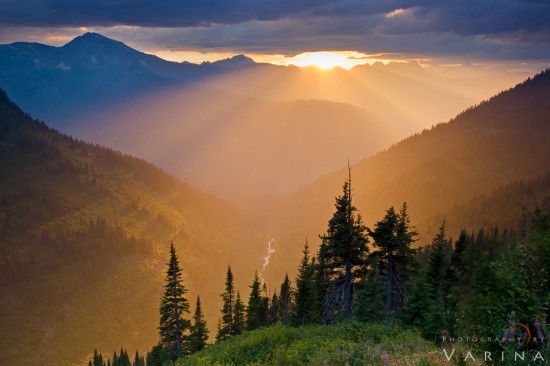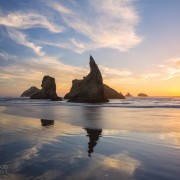In Camera Tips to Unlock the Beauty of Fine Art Photography
Nature photography is a beautiful and captivating art form that allows photographers to capture the beauty of the natural world. In the days of film photography, nature photographers manipulated their fine art photos in the darkroom. Ansel Adams himself was very accomplished in the darkroom – and he wasn’t afraid to stretch the boundaries of possibility. Nature photography on the film was very different from today’s digital cameras…there were no built-in, digital algorithms. No JPG or RAW Format or Photoshop Files… and yet, nature photographers used a variety of techniques to capture artistic photos in camera. They used colored filters to produce effects that are similar to what we can achieve in Photoshop. Using different lenses, photography composition, long exposure and more allowed nature photographers to capture artistic photos in camera.
While photoshop gives you immense control over your nature photography today, it is important to remember the in-camera techniques used during the film days can still be used to capture jaw dropping fine art photos. If you aspire to elevate your work and capture stunning artistic nature photos, here are some essential tips to refine your vision and craft jaw-dropping images.
Use Photography Composition to Direct Viewers Attention
Composition is the foundation of compelling nature photography. By carefully arranging elements like color, texture, light, and tonal range, you can direct the viewer’s attention to your subject and create visually striking fine art photos.
Here is an example from Glacier…where i have used various compositional elements to create visual impact. I wanted to capture these breathtaking light rays from Going to the Sun Road in Glacier National park. I used the Silver streak formed by the river in the valley as a leading line….while the pine trees directed the viewers attention to the breathtaking light rays which are my subject. What you don’t see in this nature photography composition are the distractions – Car parked behind me…the roads going off in different directions to my right and left…or the construction debri and a culvert in the foreground. I used a nature photography composition to build a photo around my subject.
Use Shutter Speed to create Artistic Motion Effects
Shutter speed is an important tool in photography that can be used to create artistic and dynamic nature photos. By controlling the amount of time the camera’s shutter remains open, you can create artistic motion effects. Use a fast shutter speed to freeze motion, a slow shutter speed to create blur, or a long exposure to capture the passage of time.
Here are some nature photography tips on how to use shutter speed to capture artistic photos in camera:
Freeze Motion using a Fast Shutter Speed
To freeze motion in a nature photo, use a fast shutter speed. This is especially useful for capturing birds in flight, running animals, or flowing water. A shutter speed of 1/1000th of a second or faster will help reveal details that you cannot always see in real life. I used a fast shutter speed to freeze the motion and capture incredible details that are not seen with our eyes, the abstract photos of waves exploding in Australia.
Creative Blur Effect
To create beautiful blur effects in nature photos, use a slow shutter speed. This is especially useful for capturing flowing water, wind-blown grass, or the movement of leaves in the wind. Start with shutter speed of 1/15th of a second or slower to create a beautiful blur effect. But don’t be afraid to experiment with different speeds and techniques to find the perfect shot.
Long Exposure Photography
Long exposure photography is a technique that involves using a slow shutter speed to capture the movement of the subject over a longer period of time. This is especially useful for capturing star trails, light trails, or the movement of clouds. I used a long exposure to blur the motion of the clouds and the water in the above photo from Glacier National Park, Montana. Use a tripod and a remote release to keep the camera steady during a long exposure, and use a shutter speed of several seconds or longer.
Shutter speed is a powerful tool in photography that can be used to create artistic and dynamic nature photos. By freezing motion, creating blur, panning, using long exposure, and experimenting with different speeds, you can capture beautiful and unique images that showcase the beauty of nature.
Use Shallow Depth of Field
Using shallow depth of field is a popular technique in nature photography for creating artistic and visually striking images. It can be especially effective in nature photography, allowing you to isolate your subject and create a sense of depth in your images.
Here are some tips on how to use shallow depth of field for fine art photography:
Choose a Wide Aperture
The aperture is the opening in the lens through which light passes. To achieve shallow depth of field, you will need to choose a wide aperture, such as f/2.8 or f/1.8. A wide aperture will allow you to blur the background and focus on your subject, creating a shallow depth of field.
Focus on Your Subject
When using shallow depth of field, it is important to focus on your subject to ensure that it is sharp and in focus. Use single-point autofocus to focus on the subject’s eyes, for example, or on a specific part of a flower or plant.
Get close to Your Subject
Shooting close to your subject will help you to achieve a shallow depth of field. Use a macro lens or get as close as you can to your subject to achieve maximum blur in the background. If your subject is small you may require a macro photography lens to get close to your subject.
Use a Telephoto Lens
Using a longer lens, such as a telephoto lens, can also help you to achieve a shallow depth of field. The longer focal length will compress the background, making it easier to blur out. I used a macro lens with 180mm focal length and a close focusing distance to blur the background of my subject from this image from California. This eliminated distractions and focused my viewers attention to my subject.
Pay attention to the background
When using shallow depth of field, the background can make or break the shot. Pay attention to the background and choose a location that is uncluttered and complementary to your subject. Use a wide aperture to blur the background and create a sense of depth.
Shallow depth of field is a powerful technique in photography that can be used to create stunning fine art photos. When shooting with shallow depth of field, experiment with different angles to find the most interesting and visually striking composition. Try shooting from a low angle, for example, or from a high angle to create a sense of drama and depth. By choosing a wide aperture, focusing on your subject, getting close, using a longer lens and paying attention to the background, you can achieve unique fine art photos that showcase the beauty of your subject.
Use Available Light to add Mood and Drama
Lighting is the soul of photography. Understanding and utilizing available light can transform your nature photos:
- Golden Hour: Capture warm, soft light during the hour after sunrise or before sunset.
- Blue Hour: Use the cool tones of twilight for ethereal effects.
- Midday Challenges: During harsh daylight, focus on reflections, patterns, and textures or shift to black-and-white photography for dramatic contrast.
Example: While photographing geysers in Iceland, I harnessed the soft, diffused evening light to enhance the mood and create fine art-worthy imagery.
Light is the most critical aspect of photography. The way light falls on your subject can make or break your image. The best time to shoot nature photos is during the golden hour, which is the hour after sunrise and the hour before sunset. During this time, the light is soft, warm, and creates long shadows that add depth and dimension to your photos. Alternatively, you can also experiment with shooting during the blue hour, which is the time just before sunrise and after sunset. This time creates a beautiful blue hue that adds a unique element to your images.
Capturing good landscape photos at midday can be challenging because the light is often too harsh and the shadows are too dark. However, there are a few things you can do to make the most of the light and capture great landscape photos during the middle of the day.
- Look for reflections: Midday light can create beautiful reflections in water and other reflective surfaces. Look for reflections that add interest and beauty to your photos.
- Focus on Smaller or Macro Subjects: During midday we look for smaller subjects that are completely in share or in sun. If your subject is small enough you can use a small reflector or a diffuser to balance out the harsh midday light.
- Look for interesting patterns and textures: The harsh light of midday can create interesting patterns and textures in the landscape. Look for patterns and textures that add interest and beauty to your photos.
- Experiment with black and white: Experimenting with black and white can help you create more dramatic and striking photos. The harsh light of midday can create interesting contrast in black and white photos.
Capturing good landscape photos at midday can be challenging but with a little bit of creativity and experimentation, you can create beautiful and striking photos.
Practice Patience and Persistence
Nature photography is as much about timing as it is about technique. Revisit locations to capture them in different seasons, weather conditions, or lighting. Take time to observe your surroundings and wait for the perfect moment to capture unique wildlife behavior or fleeting light phenomena. Additionally, you may need to revisit a nature photography location several times to capture the perfect light, seasons or weather conditions. Remember, the best nature photos are the ones that are well thought out and executed, so take your time and don’t rush the process.
Capturing stunning nature photos requires technical skills, creativity, and a deep understanding of your environment. By focusing on photography composition, mastering shutter speed, achieving shallow depth of field, and harnessing natural light, you can elevate your craft and create artistic photos that stand out. Practice patience, refine your techniques, and let your passion for nature photography guide you toward creating images that inspire and captivate.
















